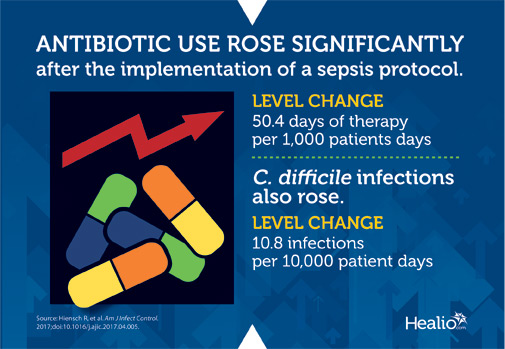October 05, 2017
3 min read
 This article is more than 5 years old. Information may no longer be current.
This article is more than 5 years old. Information may no longer be current.
Antibiotic use, C. difficile increase under electronic sepsis protocol
Test.docx
The implementation of an electronic sepsis protocol coincided with greater use of broad-spectrum antibiotics and an increase of Clostridium difficile infections at a teaching hospital, according to recently published findings.
“Integrated sepsis care streamlines how treatment is delivered,” Jashvant Poeran, MD, PhD, assistant professor of population health and science policy at the Icahn School of Medicine, said in a press release. “Yet as our research indicates, providers face the tough task of addressing how to deliver timely sepsis care, while mitigating potential unintended consequences such as an increase in health care facility-onset Clostridium difficile infection that may be linked to increased use of broad-spectrum antibiotics.”
Poeran and colleagues retrospectively reviewed time series data from a 1,171-bed tertiary care teaching hospital from June 1, 2011, to June 30, 2014. All adult patients from four wards — chosen either because they were the wards piloting the sepsis intervention or because they had the highest incidences of C. difficile, antibiotic use and sepsis — were included in the study. The main outcomes were incidence of health care facility-onset (HCFO) C. difficile infections (CDIs) and use of broad-spectrum antibiotics.
Compared with baseline, overall antibiotic use rose significantly after the implementation of the sepsis protocol, the researchers reported (level change, 50.4 days of therapy per 1,000 patient-days). CDIs also rose (level change, 10.8 infections per 10,000 patient-days; P < .05 for both).
Although three antibiotics in the study were part of an order set that had been designed for the sepsis program, these drugs were not the main drivers of antibiotic use, Poeran and colleagues wrote. Cefepime was the most commonly prescribed antibiotic; however, levofloxacin, which was not part of the order set, was the largest driver of increased antibiotic use, with an increase of 32.7 days of therapy per 1,000 patient-days.
The researchers suggested that the increase in antibiotic use may have mirrored the increase in sepsis cases. However, they wrote, the increase may have also come from changes in documentation and diagnosis patterns, or from earlier diagnosis of sepsis under the new protocol.
“Although we cannot infer causality, our findings warrant further research into unintended consequences of sepsis screening programs as they are implemented in an increasing number of hospitals nationwide,” Poeran and colleagues wrote. – by Andy Polhamus
Disclosures: The researchers report no relevant financial disclosures.

Perspective
Back to Top
 Perspective
Perspective
Electronic sepsis screening and treatment protocols have been successfully implemented to improve patient outcomes. Less information is known about the unintended consequences of such programs, including nonspecific increases in broad-spectrum antibiotic use and related outcomes including HCFO CDIs. This is important because the prevalence of HCFO CDI is increasing, with the primary risk factor being broad-spectrum antibiotic use.
The article discusses the main study effects of a sepsis performance improvement program called Strengthening Treatment and Outcomes for Patients (STOP) Sepsis. Hiensch and colleagues evaluated the impact of their electronic sepsis screening program on antibiotic use and CDI rates using longitudinal, interrupted time series data. Segmented regression analysis compared outcomes among three time frames: pre-STOP Sepsis initiative, STOP Sepsis implementation, and post-STOP Sepsis initiative. Two measures were of interest: (1) administration of selected broad-spectrum antibiotics in days of therapy (DOT) per 1,000 patient-days per month, and (2) HCFO CDI cases per 10,000 patient-days per month.
Researchers found that antibiotic use and HCFO CDI rates increased during the implementation and post-implementation periods compared with baseline. Although the most commonly used broad-spectrum antibiotics were cefepime and levofloxacin (99.9 and 51.1 DOT per 1,000 patient-days/month, respectively), the main drivers of overall antibiotic use were not the antibiotics included in the sepsis order set (ie, cefepime, imipenem-cilastatin, aztreonam). Aligned with the changes in trends of combined antibiotic use, HCFO CDI rates significantly decreased before implementation (–1.4 events per 10,000 patient-days/month), and significantly increased during implementation (1.6 events per 10,000 patient-days/month) and after implementation (10.8 events per 10,000 patient-days after hospital implementation).
One of the primary conclusions of this study is that the integration of the sepsis initiative coincided with changes in broad-spectrum antibiotic use and HCFO CDI rates in adult patients admitted to medical wards. The use of levofloxacin was the cause of the increase in antibiotic use. Both HCFO CDIs and antibiotic use began to plateau in the post-implementation period. Although sepsis quality initiatives have been assessed and have found improvements in sepsis outcomes, few studies have been published on the unintended consequences of such programs. Given the observational study design, one cannot assume the STOP sepsis initiative caused increases in antibiotic use and HFCO CDI rates. Of note, changes in antibiotic use and HCFO CDI rates could have occurred independently of the STOP Sepsis initiative, although confounders like demographic changes or other hospital quality improvement initiatives cannot be excluded.
Jessica Silvaggio, MPH, CIC, CSSGB
Infection Preventionist
Children’s Hospital Los Angeles, Los Angeles, CA
Disclosure: Silvaggio reports no relevant financial disclosures.
Disclosures:
Published by:



